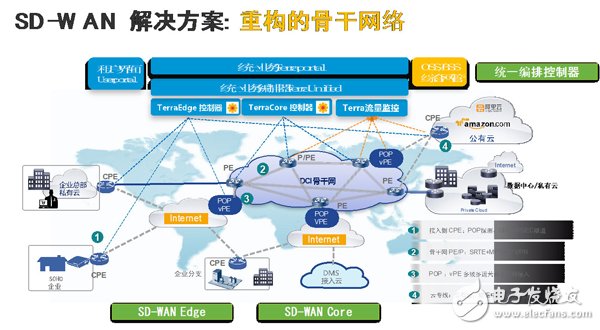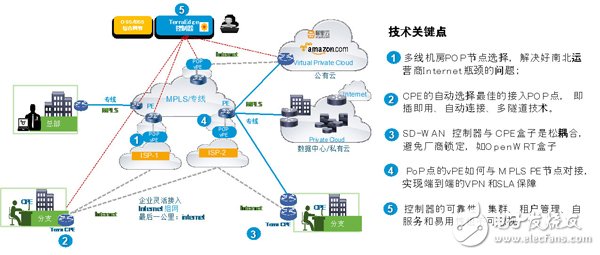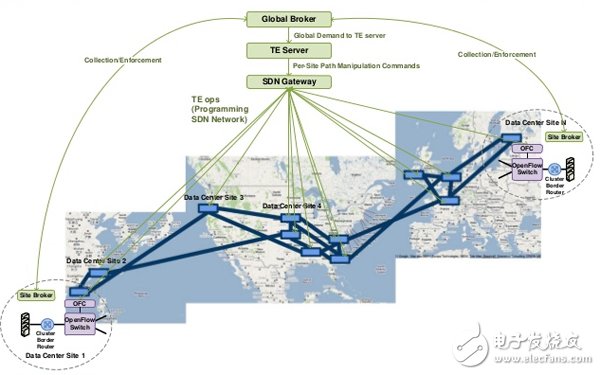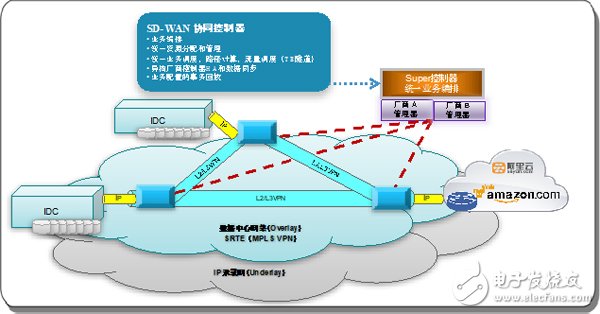Two days ago, I talked to the company's colleagues about the technology cows in the network world. Everyone accidentally talked about Tony Li, the earliest proponent of BGP4, (a Cisco predecessor), the BGP4 protocol proposed more than 20 years ago, whether in today's Internet or cloud data center. VXLAN EVPN, or based on MPLS, SegemntRouTIng and other backbone networks are still in use and inheritance development; another magical figure is Professor Nick McKeown, one of the earliest proposers of SDN architecture and OpenFlow, and now turned to the dominant programmable language P4 and founded Barefoot Networks, Professor Nick, fame and fortune in technology innovation and commercialization. Today, regardless of the latest Internet technology, the hottest cloud network convergence and SDN network, the ideas and ideas of these two legends are still inherited.

In addition to the sensation, a series of SD-WAN deployment cases on the market in 2018 will once again set off a new climax for SD-WAN. When it comes to SD-WAN, there have been many good articles on the Internet recently, especially the principle and development of many SD-WAN technologies. History, features, etc., but from the perspective of SD-WAN specific practice deployment, the article is not too much. As an old network engineer, after several major transformations of WAN technology, recently participated in several large SDN-based WANs. Building a project, on the occasion of the tenth anniversary of the development of SDN technology, the bricks and jade will share some experiences from the perspective of SD-WAN actual deployment, and share with you.
This article will share SD-WAN deployment scenarios in three different scenarios, including: SD-WAN access - Internet Edge-based solutions, SD-WAN backbone - Core solutions based on SRTE traffic scheduling, and multi-vendor WAN-based SDN collaborative controller or business collaboration orchestrator. These three scenarios are more representative, and are also the typical SD-WAN requirements currently encountered. The following figure is based on the architecture diagram of the earth cloud network, which is easy for everyone to understand!

The first type of deployment scenario:
SD-WAN access service is also the most typical and popular scenario, sometimes called SD-WAN Edge solution. Operators can use this technology as a MPLS complementary or next-generation MPLS replacement. Enterprises can use this technology to implement branch offices. Networking on demand.
On behalf of customer cases: In March 2018, Nanling Technology announced that it has become the first WAN solution service provider in China that has the ability to provide customers with MPLS VPN, IPSEC VPN, SD-WAN and other applications across the country.
Market demand: With the increasing demand for on-demand access for cloud and WAN networks, traditional MSTP and MPLS line services have been difficult to meet the needs of the cloud and Internet era due to cost and long deployment cycles. The SD-WAN for POP path selection was born, which is an SDN-WAN deployment scenario for branch flexible access. Due to the large-scale deployment of the domestic carrier MPLS VPN network, operators will not replace MPLS or other leased line services with SD-WAN in the short term, but will use SD-WAN technology to enrich MPLS VPN services or serve as the last mile of access. technology.

The main technical realization: In fact, SD-WAN has no essential innovation in technology, but SD-WAN has made a new breakthrough in the concept, incorporating SDN control ideas combined with POP line SLA detection technology, and at the same time can realize cloud network integration. Collaborative deployment, technical implementation as shown: SD-WAN general technology and general functions are not described here, there are articles written in the first two days are very detailed, here from the perspective of actual deployment:
In the SD-WAN design and deployment, in China, the Internet bottleneck problem of the North and South operators needs to be considered. When deploying the design, the customer chooses to deploy multi-line POP nodes in multiple computer rooms, deploying vPE devices in each POP node, and POP nodes. The vPE maintains the traffic SLA of the SD-WAN aggregation through the dedicated line. In this case, the vPE of the POP node is set up by the customer's MPLS PE node (in other projects, we use SRTE as the backbone network traffic scheduling). In a large SD-WAN deployment, each CPE will detect and select the best POP node based on the controller's delivery list and connect to the vPE of the best carrier line. Both Edge and Core are required for SD-WAN design. Consider the SLA guarantee of the line, and then use the SDN controller to deploy the unified routing, security and QOS policy deployment and control of the entire network to solve the problem of Internet access service quality and unified network deployment.
Another problem to be solved is how the SD-WAN tenant can connect with the existing MPLS tenant (the tenant branch may be an SD-WAN line or some MPLS private line hybrid network). As mentioned above, the major operators are basically All of them already have their own MPLS network. The connection between SD-WAN and MPLS VPN is a problem that must be considered. How can we implement multiple methods of automating the vPE at the PoP point with the MPLS PE node, including the nanotube PE, OpTIon B, Overlay and so on;
The automatic deployment of CPE and the backup and load sharing between traditional routing devices including lines are also the key factors for the success of SD-WAN. Since most manufacturers' SD-WAN controllers are tightly coupled with CPE boxes, it is later The vendor is locked, so there are a few suggestions to consider: If the CPE box supports OpenWRT? How does the small box ZT-PnP automatic deployment mechanism (firewall traversal capability)? How does CPE automatically select the access POP point with the least delay or the best bandwidth? Can you do plug and play, automatic connection, automatic switching.
For the core of the whole system is the SDN controller, the reliability, clustering, tenant self-service management and ease of use of the controller can not be ignored. As an operator, the northbound and existing BSS/ of the SD-WAN controller are usually required. OSS docking integration is also a consideration. Although there is no big innovation in SD-WAN, a complete and mature SD-WAN solution is not technically simple. The deployment and operation of SD-WAN is simple and easy to use, and enterprises no longer need professional CCIE. Personnel design and operation and maintenance, for the expansion and deployment of branches, the traditional MPLS deployment may take several months, and now the theoretical minute is OK.
The second type of deployment scenario:
SD-WAN core backbone scheduling (including DCI) for service providers and large enterprises. Typical scenarios: SD-WAN backbone scheduling (including DCI) for large operators and OTT customers, and SD-WAN core backbone for large enterprises. On behalf of the customer case: Google B4 commercial deployment SD-WAN classic case project (released in 2012) and February 2018 Industrial and Commercial Bank of China released SDN deployment based on MPLS backbone network.

The main market demand: The core idea of ​​SD-WAN backbone scheduling is traffic scheduling and multi-tenant-based service and management. Sometimes we also call it SD-WAN DCI/Core solution. This solution and the aforementioned Internet-based solution. The SD-WAN Edge is quite different in function and location, but the two solutions are complementary.
The main technical implementation, there are currently three main ways:
The first type is based on the white card machine + Openflow SDN controller - Google B4 is based on this solution (2010-2012), the core of Google B4 is its TE scheduling and algorithm and it cleverly avoids many of Openflow's flaws, including Based on the source and destination addresses, DSCP is used as the forwarding strategy of the flow table. However, the key technical details of the project (such as the SDN controller platform algorithm) are not announced or sold to the public. Later, although there are imitations, they rarely surpass. In addition to Google, I said that some customers have some questions about this combination, including white card support for SRTE, BFD/Tunnel support performance and quantity, routing strategy and VPN capabilities, switch flow table and port cache size, etc. Wait, after all, the switch solution can't be awkward, not to mention that even Nick McKeown is now turning to the dominant programmable language P4 and creating Barefoot Networks; of course, there is a new way of thinking in the industry based on the white-board Overlay solution, using vPE with white Card machine to solve the above mentioned problems, vPE and switch complement each other to achieve traffic scheduling and routing strategy Due to space problem here is not in discussion;
The second category is based on MPLS + SDN controller to achieve network-wide traffic scheduling and VPN tenant management - similar to ICBC SD-WAN backbone network (released in 2017), MPLS TE has been deployed many years ago, as seen by current carrier customer deployment Most of the complaints about the deployment of MPLS TE are too complicated, so there is not much use in the TE tunnel of the production network. Due to the advanced deficiencies of MPLS, there is no need to go into too much detail here;
The third type of solution is also what I would like to see. It is based on SR (Segment RouTIng) to implement traffic scheduling and management of SR+SDN controllers. It is similar to MPLS network, but SR can establish a complete LSP Path based on the source and The existing MPLS network is negotiable, because the SR is also based on label switching. Only the existing IGP protocol can be easily extended to implement TE, FRR, MPLS VPN and other functions, including automatic traffic engineering TE. Delivery, automatic calculation, automatic adjustment, automatic drainage and automatic scheduling.

The SRTE-based SDN controller is currently a very advanced technology in the industry. The basic forwarding table of SR is even simpler than LDP. It uses the source routing technology and SDN concept perfectly. In terms of traffic TE management, SRTE is less than RSVP-TE. Many, and do not require the complexity of LDP / RSVP signaling. However, there are still some gaps in the implementation of SRTE between hardware vendors (including third-party controllers + SR routers), but there are several points to consider when deploying:
How to dynamically adjust the TE path in real time according to link quality (load/loss/delay) to achieve global load balancing
Tunnel fast switching strategy and escape algorithm (such as Cisco PBTS technology),
Configure rollback consistency, offline traffic planning,
Symmetric fault detection of the TE path, and so on.
The functions of each solution vary greatly. There are only a handful of SDN controllers that can be truly implemented in China. As a domestic SDN architecture and software technology platform, Dadi Cloud has successfully succeeded in this difficult technical challenge after more than two years of technical breakthroughs and R&D tests. It has realized the commercial controller of the complete SR-TE for the first time. The platform and commercial deployment began.
The third type of deployment scenario:
Based on multi-vendor SDN collaborative controllers or service coordinators, large operators and OTT customers and very large enterprises have begun to consider in the SD-WAN multi-vendor heterogeneous environment.
On behalf of the customer case: China Unicom announced in March 2018 that "the first large-scale operator in China, cloud network integration commercial SDN was successfully launched (based on Unicom A network SD-WAN DCI system)" main market demand: in the first two categories SD- When WAN is deployed, customers often need multiple vendors to achieve a balance. Customers do not want to be locked by vendors. However, most SD-WAN networks are still closed management systems, based on multi-vendor SDN cooperative controllers or business collaboration. The orchestrator is a problem. The problem of interoperability and unified resource management is that the upper layer SDN cooperative controller is needed to solve this kind of solution. This kind of solution is especially important for large SDN network operations. At present, several major operators and the OTT industry are aware of or start to consider this issue. I believe that in the future, enterprise customers will have similar needs with SDN deployment.
The main technical realization: Taking an operator as an example, two years ago, the multi-vendor controllers of the MPLS backbone network under the pre-research cloud environment began to work together. After nearly two years of hard work in design, research and development, testing and joint adjustment. Efforts have made this customer the first operator in China to implement cloud network integration services on the backbone of the country. At the same time, it also created a large-scale SDN project in China, choose independent core SDN software companies and a number of large network equipment manufacturers to work together to ensure that operators can fully control, control SDN operation requirements and technical architecture direction and decision-making voice It provides a successful case for the final cloud-integrated product on-time commercial launch.
However, multi-vendor collaborative controllers need to be customized according to the actual business conditions of customers. SDN software vendors need to have strong R&D capabilities and industry experience, including a deep understanding of the northbound interface specifications of the vendor hardware and cloud technology (such as VXLAN). EVPN, L2/L3 MPLS, SR TE, Neutron, Docker CNI, ODL, etc.), the docking of mainstream public cloud systems, and integration with customer OSS/BSS service systems, etc., is actually very complicated, not a general SDN vendor. Played with the company. As shown in the figure, with the increasing deployment of SD-WAN multi-scenarios and multi-vendors, multi-vendor collaborative management and unified orchestration will become an important topic for SD-WAN in the future.

Finally, look ahead to the future of SD-WAN
SD-WAN is a new idea and architectural innovation under the background of rapid Internet development and cloud network integration. SD-WAN's breakthrough in concept is far greater than innovation in technology. Due to time and space, this time we share with you. The three types of SD-WAN related cases and deployment scenarios seem to look like three independent SD-WAN solutions, but in terms of architecture, they are a complete three-dimensional architecture.
Today's SD-WAN journey has begun. The value and significance of SD-WAN as a new business model is immeasurable. I believe that future SDN can better understand applications and serve applications (Intent-Based SDN and traffic intelligence). Analysis), providing accurate intelligent scheduling capabilities (especially in SRTE, POP detection selection algorithm), can provide more powerful intelligent operation and maintenance tools to protect Underlay and Overlay, in addition to future SDN openness, common standards and Interoperability (not locked by the manufacturer) is also the goal we have been pursuing. Don't forget the initial heart, let us wait and see.
We produce Lighting for commerical ,industrial ,and household . Specially for desk lamp LED which 360 degree bent freely .It can brighten you in any angle as
you want. Road light and functional light also.
Home Outdoor Lighting LED Stadium Light LED Floodlight LED Tri-proof Light LED Street Light LED Garden Light LED Canopy Light Indoor Lighting LED Panel Light LED Batten Light GL Series LED Batten Light GLK Series LED Batten Light
Home Lighting & Furnishings - Quality, Style and Selection. Lamps Plus offers a complete selection of indoor and outdoor lighting fixtures. From stylish ceiling light fixtures, chandeliers and trend-setting ceiling fans to thousands of designer lamps and lamp shades that are in-stock and ready to ship.
Home Light,Led Desk Lamp,Rgb Night Lamp,Bathroom Lights
Jiangmen soundrace electronics and technology co.,ltd. , https://www.soundracegroup.com